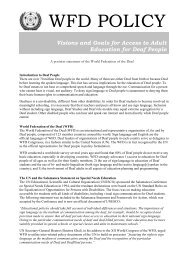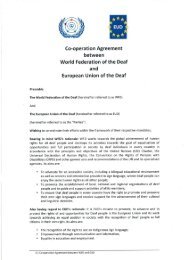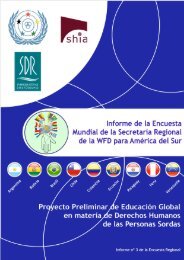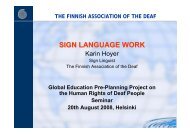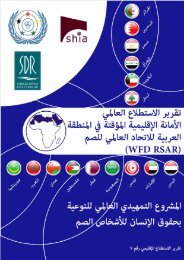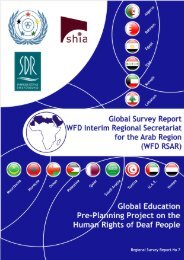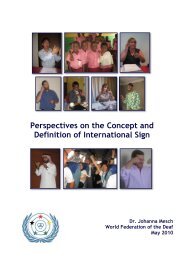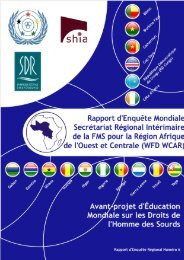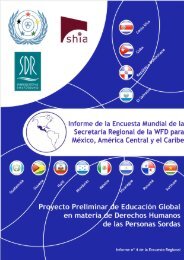Page No 1 - World Federation of the Deaf
Page No 1 - World Federation of the Deaf
Page No 1 - World Federation of the Deaf
You also want an ePaper? Increase the reach of your titles
YUMPU automatically turns print PDFs into web optimized ePapers that Google loves.
policy on <strong>Deaf</strong> Education. All six countries were able to provide <strong>the</strong> specific name <strong>of</strong> <strong>the</strong> legislation or policy relating to <strong>Deaf</strong><br />
Education, <strong>the</strong> list <strong>of</strong> which is available on page 63.<br />
The Regional Working Group queried those six countries who replied that <strong>the</strong>re was no legislation or policy on <strong>Deaf</strong> Education;<br />
<strong>the</strong> Regional Co-ordinator has extensive experience in <strong>the</strong> field <strong>of</strong> <strong>Deaf</strong> Education in <strong>the</strong> region, and he stated that in 1996<br />
every country’s government signed <strong>the</strong> “Law for Equal Opportunities for People with Disabilities” (Ley de Equiparación de<br />
Oportunidades para las personas con Discapacidad).<br />
The next aim was to collect information on educational settings for <strong>Deaf</strong> children and <strong>Deaf</strong> students in each country (11<br />
countries) as shown below:<br />
Early Intervention Kindergarten Primary Education<br />
Secondary<br />
Education<br />
7 Countries 8 Countries 9 Countries<br />
9 Countries<br />
(64%)<br />
(73%)<br />
(82%)<br />
(82%)<br />
Based on 11 respondents<br />
University<br />
Education<br />
5 Countries<br />
(45%)<br />
Vocational<br />
Education/Training<br />
6 Countries<br />
(55%)<br />
Four countries (Costa Rica, Cuba, Honduras and Panama) have educational settings from Early Intervention right up to<br />
University Education, as well as Vocational Education and Training. In Guatemala, <strong>the</strong> government is not responsible to<br />
manage schools for <strong>the</strong> <strong>Deaf</strong> but <strong>the</strong>re are schools for <strong>Deaf</strong> children managed by private institutions.<br />
It was interesting to note that Haiti ticked ‘<strong>No</strong>’ for all education levels; this could be in error because to <strong>the</strong> question ‘Does<br />
your country have any schools specifically for <strong>Deaf</strong> children and <strong>Deaf</strong> students?’ <strong>the</strong>y responded ‘Yes’. It may be that <strong>the</strong>y<br />
thought <strong>the</strong> above question referred to <strong>the</strong> governmental school system while in <strong>the</strong>ir country <strong>the</strong> schools are run by private<br />
non-governmental organisations only.<br />
The WFD MCAC Regional Director visited <strong>the</strong> Dominican Republic where he was hoping to obtain information on educational<br />
settings; unfortunately he was unable to do so, <strong>the</strong>refore all information for <strong>the</strong> Dominican Republic is recorded as Unknown.<br />
Ano<strong>the</strong>r question addressed Bilingual Education <strong>of</strong>fered by <strong>the</strong> government, and use <strong>of</strong> <strong>the</strong> national sign language(s) for <strong>Deaf</strong><br />
children and <strong>Deaf</strong> students. Seven out <strong>of</strong> 12 countries (Costa Rica, Cuba, El Salvador, Honduras, Mexico, Nicaragua and<br />
Suriname) provided information about which levels <strong>of</strong> education are provided bilingually:<br />
Early Intervention Kindergarten<br />
6 Countries<br />
(86%)<br />
5 Countries<br />
(71%)<br />
Primary<br />
Secondary<br />
Education<br />
Education<br />
7 Countries 7 Countries<br />
(100%)<br />
(100%)<br />
Based on seven respondents<br />
University<br />
Education<br />
4 Countries<br />
(57%)<br />
Vocational<br />
Education/Training<br />
5 Countries<br />
(71%)<br />
The next question had <strong>the</strong> aim <strong>of</strong> recording <strong>the</strong> number <strong>of</strong> schools specifically for <strong>Deaf</strong> children and <strong>Deaf</strong> students; all 12<br />
countries provided replies. The largest number <strong>of</strong> <strong>Deaf</strong> schools is in Cuba, which has 16; and <strong>the</strong> smallest number is in Guyana<br />
and Suriname, which each have only one. The total number <strong>of</strong> <strong>Deaf</strong> schools, hearing schools with <strong>Deaf</strong> classrooms, <strong>Deaf</strong> units<br />
and o<strong>the</strong>rs, in all 12 countries is 96.<br />
Ano<strong>the</strong>r question approached <strong>the</strong> type <strong>of</strong> educational communication methods for <strong>Deaf</strong> children and <strong>Deaf</strong> students at <strong>the</strong> <strong>Deaf</strong><br />
schools. All 12 countries provided this information; <strong>the</strong> summarised results are:<br />
Bilingual Education 1 Oral Method 2 Cued Speech 3 Oral and Sign Language<br />
(Total Communication) 4<br />
6 Countries 8 Countries 1 Country<br />
9 Countries<br />
(50%)<br />
(67%)<br />
(8%)<br />
(75%)<br />
Based on 12 respondents<br />
Auditory Verbal 5 O<strong>the</strong>r<br />
2 Countries<br />
(17%)<br />
1 Country<br />
(8%)<br />
1 Bilingual Education: Sign language is considered to be <strong>the</strong> natural language (‘mo<strong>the</strong>r tongue’) that will be acquired as a first<br />
language. Spoken language, which is not acquired naturally by <strong>Deaf</strong> children, will be learned as a second language as <strong>the</strong> child<br />
becomes cognitively/developmentally ready. Both languages are used throughout <strong>the</strong> child’s entire education.<br />
2 Oral Education: Spoken language is assumed to be <strong>the</strong> basis for standard social and academic communication, and <strong>the</strong> human<br />
system is assumed to be designed (pre-wired) to learn language expressed in speech. Children learn about and from spoken<br />
language. Also known as auditory-oral, aural/oral education. Emphasis on speech.<br />
3 Cued Speech: A visual mode <strong>of</strong> communication that uses hand shapes and placements in combination with <strong>the</strong> mouth<br />
movements <strong>of</strong> speech to make <strong>the</strong> phonemes <strong>of</strong> a spoken language look different from each o<strong>the</strong>r, resulting in a visual<br />
counterpart <strong>of</strong> a spoken language.<br />
4 Total Communication: All forms and modes <strong>of</strong> communications are used. This includes natural gestures, sign language,<br />
manually-coded spoken languages, sign systems, mime, audition and speech.<br />
5 Auditory Verbal Education: Supposes that even minimal amounts <strong>of</strong> residual hearing can lead to <strong>the</strong> development <strong>of</strong><br />
spontaneous speech and language, if that residual hearing is stimulated. Children learn to process language through amplified<br />
hearing. A method <strong>of</strong> oral education with an emphasis on listening.<br />
The Project was under <strong>the</strong> auspices <strong>of</strong> <strong>the</strong> Swedish National Association <strong>of</strong> <strong>the</strong> <strong>Deaf</strong> (SDR) and <strong>the</strong> <strong>World</strong> <strong>Federation</strong> <strong>of</strong> <strong>the</strong> <strong>Deaf</strong> (WFD), <strong>Page</strong> <strong>No</strong> 19<br />
and funded by <strong>the</strong> Swedish Agency for International Development Cooperation (Sida) and Swedish Organisations’ <strong>of</strong> Disabled Persons<br />
International Aid Association (Shia).



